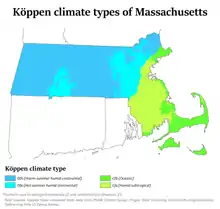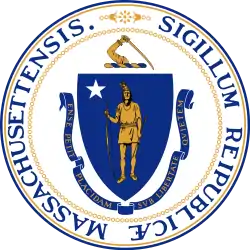Climate change in Massachusetts
Climate change in Massachusetts will affect both urban and rural environments, including forestry, fisheries, agriculture, and coastal development.[1][2][3] The Northeast is projected to warm faster than global average temperatures; by 2035, the Northeast is "projected to be more than 3.6°F (2°C) warmer on average than during the preindustrial era."[3]

Impacts of climate change
Sea level rise
.jpg.webp)
The city of Boston has identified specific projects in East Boston, Charlestown, and South Boston that would raise small parcels of land and use temporary barriers in key locations to prevent flooding during storms, which due to climate change will be higher than present.[4] In 2016, Climate Ready Boston recommended studying the feasibility of a storm tidal barrier for Boston Harbor.[5] The resulting report from the University of Massachusetts Boston Sustainable Solutions Lab concluded that such a barrier would not be cost-effective compared to a larger number of smaller-scale on-shore projects.[6] A 2016 Executive Order established a climate change strategy for the Commonwealth.[7]
A 2018 noreaster caused flooding in downtown Boston, Quincy, and Scituate, raising more concerns about the impact of sea level rise.[8]
Response
State laws and legislative action
Former Massachusetts Governor Deval Patrick signed into law three global warming and energy-related bills that will promote advanced biofuels, support the growth of the clean energy technology industry, and cut the emissions of greenhouse gases within the state. The Clean Energy Biofuels Act, signed in late July, 2008, exempts cellulosic ethanol from the state's gasoline tax, but only if the ethanol achieves a 60% reduction in greenhouse gas emissions relative to gasoline. The act also requires all diesel motor fuels and all No. 2 fuel oil sold for heating to include at least 2% "substitute fuel" by July 2010, where substitute fuel is defined as a fuel derived from renewable non-food biomass that achieves at least a 50% reduction in greenhouse gas emissions. The requirement for both motor diesel fuel and heating oil increases by a percentage point per year until 2013, after which it holds steady 5%. The act also allows the state to expand the requirement to other forms of fuel oil, and it requires the state to work to establish a low-carbon fuel standard under the Regional Greenhouse Gas Initiative.
In early August 2008, Governor Patrick signed two additional bills: the Green Jobs Act and the Global Warming Solutions Act. The Green Jobs Act will support the growth of a clean energy technology industry within the state, backed by $68 million in funding over 5 years. The Global Warming Solutions Act[10][11] requires a reduction of greenhouse gas emissions in the state to 10%-25% below 1990 levels by 2020 and to 80% below 1990 levels by 2050. Under the act, the Massachusetts Department of Environmental Protection will carry the burdens of determining the baseline level of emissions in 1990 and creating a plan to meet the future emissions limits, including the establishment of interim limits for 2030 and 2040.
In December 2019, Massachusetts joined consideration for a multi-state gasoline cap-and-trade program. The plan aims to reduce transportation-related tailpipe emissions, and would levy a tax on fuel companies based on carbon dioxide emissions. The most ambitious version of the plan is projected to reduce the area's tailpipe emissions by 25% between 2022 and 2032. The program is in the public comment phase, with individual states determining whether to participate. The program could begin as early as 2022.[12]
In late 2020, the Massachusetts released a Decarbonization Roadmap that aims for net zero greenhouse gas emissions by 2050. The plan calls for major investments in offshore wind and solar energy, heating and cooling upgrades to millions of buildings and would require all new automobiles sold to be zero emissions (electric or hydrogen powered) by 2035.[13][14]
Response by municipalities
In addition to state initiatives, several municipalities within Massachusetts have released their own climate action plans, including Boston.[15]
Collective buying of electricity
The Massachusetts Institute of Technology, Boston Medical Center, and the Post Office Square Redevelopment Corporation bundled their electricity purchasing power in 2016 to finance construction of a 6-megawatt solar farm in North Carolina. The City of Boston is planning a similar initiative with cities across the country.[16]
See also
References
- EPA. "What climate change means for Massachusetts" (PDF).
- "Effects of Climate Change in Massachusetts". Mass Audubon. Retrieved 2020-04-23.
- Dupigny-Giroux, L.A.; E.L. Mecray; M.D. Lemcke-Stampone; G.A. Hodgkins; E.E. Lentz; K.E. Mills; E.D. Lane; R. Miller; D.Y. Hollinger; W.D. Solecki; G.A. Wellenius; P.E. Sheffield; A.B. MacDonald; C. Caldwell (2018). "Northeast". In Reidmiller, D.R.; C.W. Avery; D.R. Easterling; K.E. Kunkel; K.L.M. Lewis; T.K. Maycock; B.C. Stewart (eds.). Impacts, Risks, and Adaptation in the United States: Fourth National Climate Assessment, Volume II (Report). Washington, DC, USA: U.S. Global Change Research Program. pp. 669–742. doi:10.7930/NCA4.2018.CH18.
- Climate Ready Boston
- Editorial: Costly plans wrong way to solve coastal flooding
- "UMass Boston Report: Boston Harbor Barrier Costs Would Outweigh Benefits". 2018-05-29.
- https://www.mass.gov/service-details/massachusetts-sea-level-rise-and-coastal-flooding-viewer
- Photos: Scenes from the powerful nor’easter
- "Effects of Climate Change on Salt Marshes".
- "Massachusetts Global Warming Solutions Act (S. 2540 MA) | Adaptation Clearinghouse". www.adaptationclearinghouse.org. Retrieved 2020-05-17.
- Massachusetts Session Laws. (August 7, 2008), An act establishing the Global Warming Solutions Act., Chapter 298
- Tabuchi, Hiroko (17 December 2019). "Eastern States Introduce a Plan to Cap Tailpipe Pollution". The New York Times. Retrieved 26 March 2020.
- Martin, Naomi (December 30, 2020). "Mass. to require all new cars sold to be electric by 2035 as part of climate-change measures". The Boston Globe.
- Massachusetts 2050 Decarbonization Roadmap
- "Boston Climate Action". Boston.gov. 2019-01-23. Retrieved 2020-05-17.
- Power brokers: Boston to join other cities to collectively buy energy from renewable sources
Further reading
Dupigny-Giroux, L.A.; E.L. Mecray; M.D. Lemcke-Stampone; G.A. Hodgkins; E.E. Lentz; K.E. Mills; E.D. Lane; R. Miller; D.Y. Hollinger; W.D. Solecki; G.A. Wellenius; P.E. Sheffield; A.B. MacDonald; C. Caldwell (2018). "Northeast". In Reidmiller, D.R.; C.W. Avery; D.R. Easterling; K.E. Kunkel; K.L.M. Lewis; T.K. Maycock; B.C. Stewart (eds.). Impacts, Risks, and Adaptation in the United States: Fourth National Climate Assessment, Volume II (Report). Washington, DC, USA: U.S. Global Change Research Program. pp. 669–742. doi:10.7930/NCA4.2018.CH18. -- this chapter of the National Climate Assessment covers Northeast states
External links
- City of Boston sea level rise flood interactive map
- How will global warming of 2°C affect Massachusetts?, University of Massachusetts
- Nestor Ramos, At the Edge of a Warming World September 26, 2019 BostonGlobe.com

